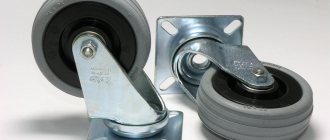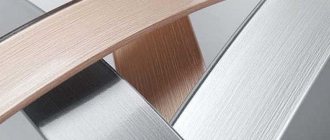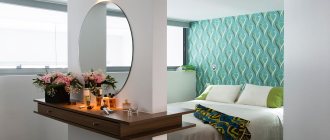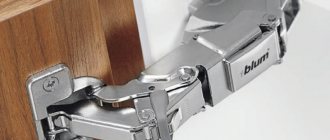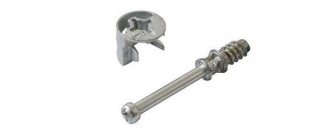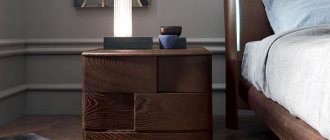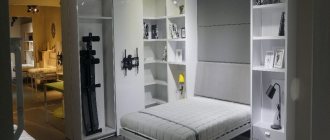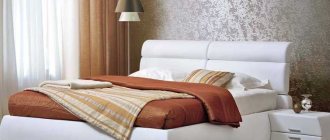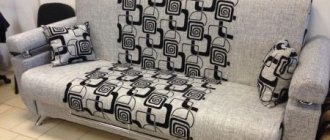Purpose and features
Edges are strips of a specific color palette, made from various materials. Products are classified by width, thickness, and price category. They also differ depending on the purpose of the furniture. Such elements protect the chipboard from moisture and mechanical stress, and reduce the influence of formaldehyde (which is contained in the board) on the user. Each type of finishing material has its pros and cons; they must be taken into account when choosing edges for furniture.
The product is widely used in the manufacture of wardrobes, walls in the hallway, bedroom, kitchen and children's furniture. There are special varieties that perform the function of shock absorption when hitting the end plate. This type of furniture edge is used in the production of cabinets, shelves for educational and preschool institutions, as well as for furniture installed in a children's room.
The advantage of the material is a wide range of colors, which helps to provide a designer approach to the design of a living or working space. German manufacturers offer, in addition to a variety of colors (up to 5000 shades), different textures. The edge tape can be smooth to the touch or imitate the texture of wood, tangerine peel, leather, and so on.
Furniture strips are recommended for repairing and updating old walls, tables, shelves, and when making new furniture with your own hands at home. Moisture getting into unprotected parts of the chipboard can result in its deformation and distortion of the entire product.
Varieties
Edge materials are divided into several types according to the following parameters:
- manufacturing material - plastic, metal, paper;
- profile shape - U-shaped, T-shaped;
- width and thickness of the tape;
- gluing option - self-adhesive or regular surface.
The most common edging options are melamine, plastic and acrylic.
Plastic
Metal
Paper
U-shaped
T-shaped
Various in width and thickness
Self-adhesive
Regular
Melamine
Furniture edging is an inexpensive single-layer or multi-layer decorative finish on a paper base impregnated with melamine-formaldehyde resin. Both a self-adhesive version of the tape and one without an adhesive surface are produced. The former is easily applied to the end surface at home, while the latter is usually used in production shops where economy-class furniture is processed. A variety of colors allows you to choose your favorite option for any laminated chipboard (LDSP).
Features of using stickers on furniture, choice of materials and themes
Advantages of melamine protective tape:
- low cost;
- ease of application (both in production and at home);
- the pasting process does not require expensive equipment;
- wide range of colors.
The disadvantages of the product are considered to be:
- fine structure;
- low impact resistance;
- poor protection from humid air;
- fragility of the color image.
The melamine variety is made in various widths, which allows it to be used for a variety of furniture configurations, including for covering tabletops.
Plastic (ABS, PVC)
This edge material is distinguished by its impact resistance and resistance to temperature changes - from -30 to +100 ⁰С. Chlorine-free raw materials are easily recycled and are widely used in the domestic market and in EU countries.
Among the advantages of the material:
- does not emit compounds harmful to health;
- characterized by a beautiful smooth glossy or matte surface;
- Available in bright, rich colors;
- does not lose color over time and is not deformed;
- low toxicity when heated;
- resistant to aggressive chemical environments;
- when applied using a machine, it does not require low-temperature adhesive compositions, since it does not melt up to 100 ⁰C.
The disadvantages of ABS include its high cost compared to other types of edges.
Many consumers know what PVC (polyvinyl chloride) is. It is the most common plastic used in various industries. It is popular in the furniture industry. The composition is manufactured using a technological process called extrusion. The tape can withstand temperature fluctuations from -10 to +50 ⁰С. Available with a rich texture like wood, metal, plain, on a soft and hard base.
Pros of PVC material:
- high-quality impact protection;
- resistance to fire, moisture, chemical effects of acids, alkalis, salts;
- long service life;
- does not require special storage conditions;
- The price and quality are suitable for many consumers.
Users call the disadvantages of PVC tape:
- impossibility of extruding a smooth glossy strip;
- the need to purchase special glue with a low melting point to fix the edge to the chipboard.
In color design, plastic edges match many shades of chipboard.
Acrylic edge
A new generation of end tapes, in the manufacture of products, transparent plastic is used, called organic glass (PMMA), on the inside of which an image is applied - a 3D effect is obtained. The tapes are smooth and protect furniture well from impacts and exposure to aggressive environments. Used for chipboards located on the outside.
Types of furniture facades, their design options
The main advantages of the products include:
- strength;
- moisture resistance - can be used in the bathroom;
- resistance to aggressive environments - alkali, acid, ultraviolet radiation;
- resistance to temperature changes - from -35 to +85 ⁰С.
The disadvantages of acrylic include its high cost relative to other plastic edges. According to the shape of the profile, there are PVC edges of the U-shaped (overhead) and T-shaped (built-in) types. Products with an overlay profile are flexible and rigid. They are easier to stick at home. The disadvantage of this form is the protruding sides, near which dust and dirt accumulate over time.
The built-in profile is usually made of quite large thickness and hides the shortcomings of poor-quality cutting. It is considered reliable and durable, but requires a special groove at the end of the plate into which it is inserted.
Overlay and mortise edges
This type of edging is more decorative. It does not protect furniture parts from swelling and drying out, but only gives an attractive three-dimensional shape to the ends. It is used only for the design of visible ends - facades, cornices, countertops, open shelves, etc.
As is clear from the name, the overlay (U-shaped) and mortise edge does not require a sticker (in rare cases, only additional fixation, support), it is attached using protruding parts, wrapping around the end of the part or cutting into a specially prepared recess in the center of the end. They make flexible overlay and mortise edges from PVC and use them to decorate tabletops in office and student furniture.
The aluminum end, which frames the facades and countertops of kitchens, premium-segment office furniture, reception desks, etc., deserves special attention. Since the aluminum end is not able to go around corners, additional accessories are required for its installation - internal and external corners. Sometimes craftsmen do without them, sawing and joining the end at the desired angle.
Product dimensions
Depending on the material that covers the furniture end saw, there are standard sizes of the protective tape.
| Material | Width, mm | Thickness, mm |
| Melamine | 19; 20; 22; 23; 40; 43 | 0,2; 0,3; 0,4 |
| PVC | 22; 23; 32; 34; 42 | 0,4; 0,45; 0,6; 1; 2; 4 |
| ABS | 22; 23; 28; 43; 45; 54 | 0,4; 0,8; 1,3; 1; 2 |
| PMMA (acrylic) | 22; 23; 45; 54 | 1; 2 |
A fairly wide range of materials and sizes allows everyone, even the most demanding buyer, to make a choice. Finishing material of fine structure is usually used for internal shelves in cabinets, chests of drawers, tables and so on. A thicker tape is applied to the outside of the furniture. The width is selected depending on the thickness of the chipboard.
A wide edge can connect the ends of two folded particle boards.
Melamine
PVC
ABS
Acrylic
Tips for choosing
Before choosing and purchasing a product, you need to decide what kind of furniture needs to be covered with edging. If it is an old cabinet and needs to be updated, there is no point in buying an expensive product, paper or PVC tape will do. For a children's set, an edge with good protection and shock-absorbing properties is desirable - at least 1 mm. When making furniture yourself, you need to focus on your budget and aesthetic tastes in order to match the cost with the quality.
Experts recommend using the following tips:
- it is better to give preference to a product from a well-known manufacturer, even if it is a little more expensive, but the quality will not let you down;
- For work around the house, tapes that already have an adhesive surface are suitable;
- for low-quality chipboard cuts, you should choose a thick profile PVC edge, it will hide the imperfections of the end;
- you need to pay attention to the color and textured pattern of the product, as they may not fit the slab;
- high-quality glue from a well-known manufacturer plays an important role;
- it is necessary to carefully measure the width of the slab so as not to make a mistake with the width of the purchased product;
- You can connect two slabs with one wide edge.
A thick decorative tape will not look very nice, so for high-quality protection it is worth using a product 1 mm wide.
For home use, it is better to choose self-adhesive tapes
You need to pay attention to the color and texture of the product.
It is necessary to carefully measure the width of the slab
Scope of use
Regardless of what type of edge is used, it is designed to protect the end parts of the product. Such a device is especially necessary when producing inexpensive furniture from chipboard or laminated chipboard. Since these materials contain harmful formaldehydes, which over time can evaporate their substances into the atmosphere. Edge materials allow you to cover raw edges, preventing the spread of fumes.
Independent production of furniture parts implies the mandatory use of edging. If this is not done, then during operation the uncovered edges of the product will be subject to rapid wear.
Possible causes include accidentally touching the edge, scratching with a sharp object, or carelessly closing the doors. This is why processing chipboard with edge material is so important in furniture production
To consolidate the information provided, it is necessary to highlight a number of functions performed by the edge - a special tape made from various raw materials for processing the edges of furniture:
- Beautiful appearance of the ends of the products. When shopping in a store, the buyer first of all looks at the aesthetic design. It is unlikely that he will want to install a sliding wardrobe where the internal shelves look unfinished, and their edges differ in color and structure from the facades;
- Protection from mechanical damage. Edge materials are designed to protect fragile chipboards from moisture and delamination. Chips and burrs caused by impacts can cause snags on clothing and scratches on the skin. The laminated surface of furniture can crack even when in contact with a hard object. If the edges of the parts are sealed with edging, the degree of damage and the chances of loss of attractiveness of the models are minimal;
- Protecting human health. As already mentioned, the edge plays an important role in maintaining the health of household members. The longer the furniture is used, the higher the risk of formaldehyde resins escaping from the chipboard.
When choosing products for your home, you should pay attention to these subtleties. They will help maintain the attractiveness of furniture and extend its safe use.
How to apply it yourself
At home, the easiest way to work is with self-adhesive melamine tape. To work you will need the following tools:
- knife for cutting off excess material (construction, shoe, stationery);
- a device for heating the working surface (iron or hair dryer);
- rags or piece of felt;
- fine sandpaper;
- a vice or an assistant who will hold the slab in a fixed position;
- roulette.
Features of decoupage furniture using various materials
After preparing the workplace, install and clamp the chipboard in a vice with the processed end facing up. Using a tape measure, measure the length of the end, and then the same length of the edge with an addition of 2 cm for error and shrinkage of the material when heated. The product is applied to the end and gradually warmed up along the entire length in small sections (35–40 cm). After heating, each zone, until the glue has hardened, is ironed with a rag or felt to level the surface layer. After the glue has dried, the excess tape is carefully trimmed with a knife, and the sharp edges are lightly sanded with sandpaper so as not to scratch the plate. Remove dust with a damp cloth.
When installing decorative tape without adhesive, you can use Moment rubber adhesive, after waiting a certain time before pressing the edge to the end. Other adhesive compositions are also used, in which the technology must be maintained over time. In the same way, you can apply a thin PVC edge yourself. The thick variety is difficult to trim after application - special tools are needed.
Furniture edges are an important element of walls, cabinets, shelves, and other furniture. With the right choice, it will last for many years, protecting the base material from damage and exposure to adverse factors. The main thing is to approach the purchase responsibly.
Edge gluing
Furniture edging PVC
This type of edge is made of polyvinyl chloride. There are only two types - 2 and 4 mm thick. Denser tapes are used in places that are subject to increased loads. Thin options are used to cover the front surfaces of furniture. The cost of PVC edges varies from 10 to 20 rubles per linear meter.
Advantages:
- Large selection of colors.
- Polyvinyl chloride is not flammable.
- High level of wear resistance.
- Durability.
- Maximum protection of the ends from mechanical damage and moisture penetration.
- Resistant to various substances (acids, alkalis).
Flaws:
- Difficult to install. The only method of fastening is specialized machines. For this reason, it is impossible to secure the PVC edge yourself.
- Rigidity. This criterion can be attributed to both advantages and disadvantages. Due to its rigidity, it is quite difficult to make the surface being treated smooth. However, it is precisely this that significantly increases the protective properties of the edge.
